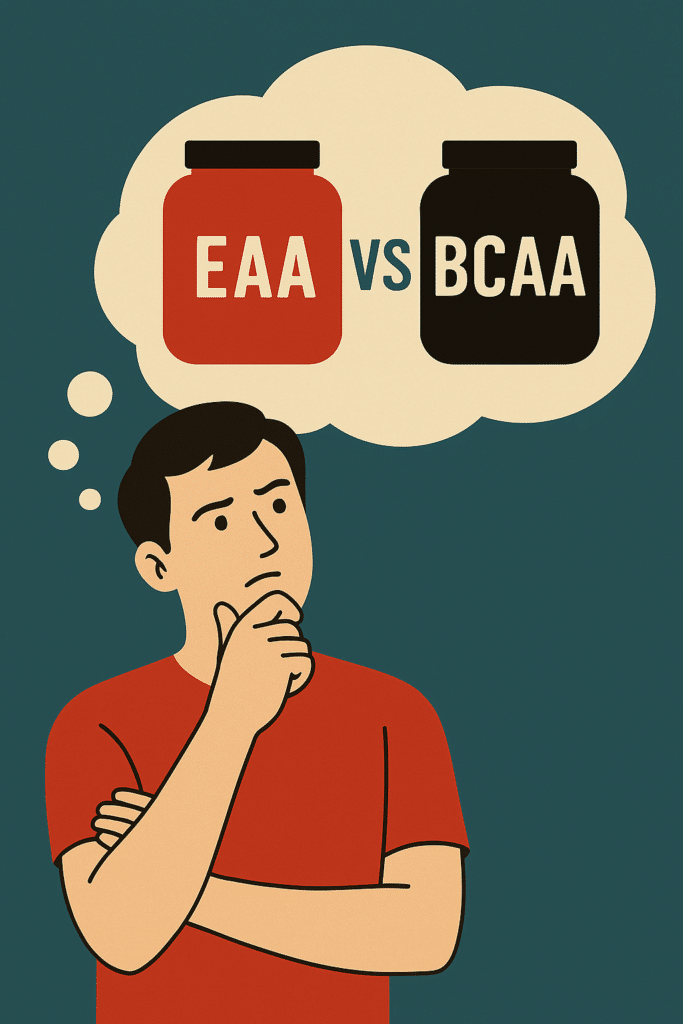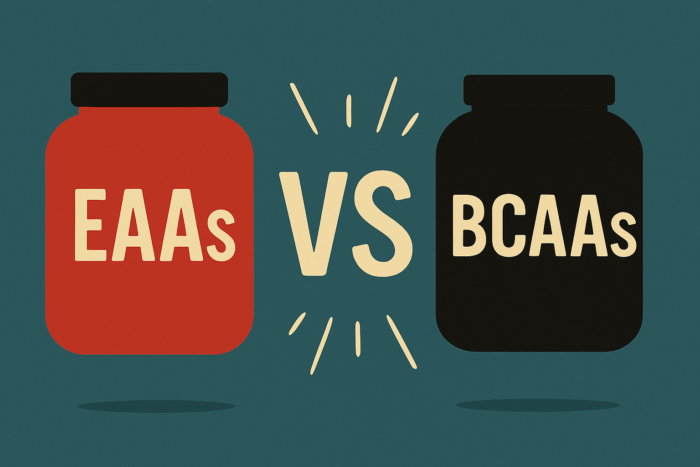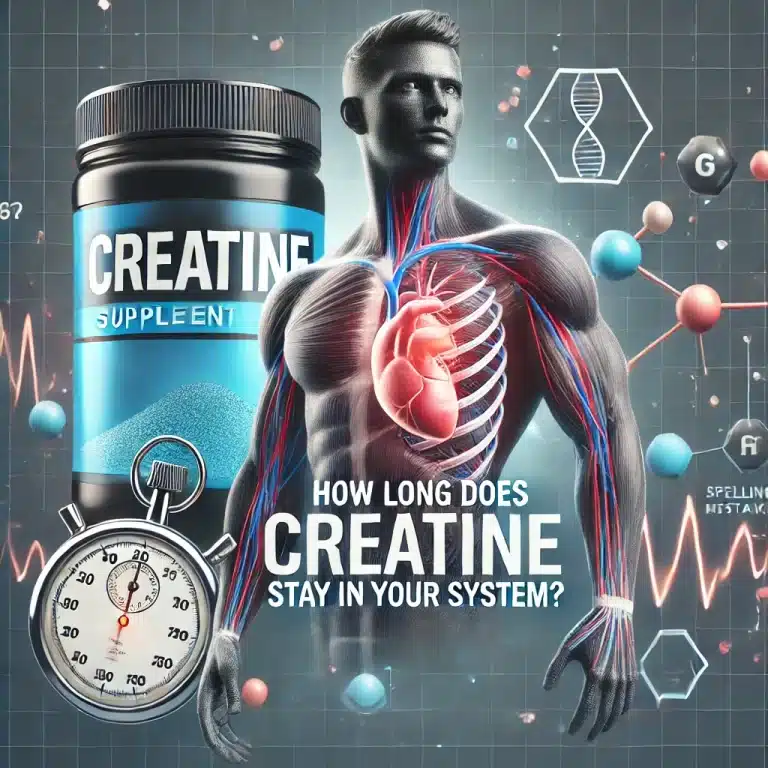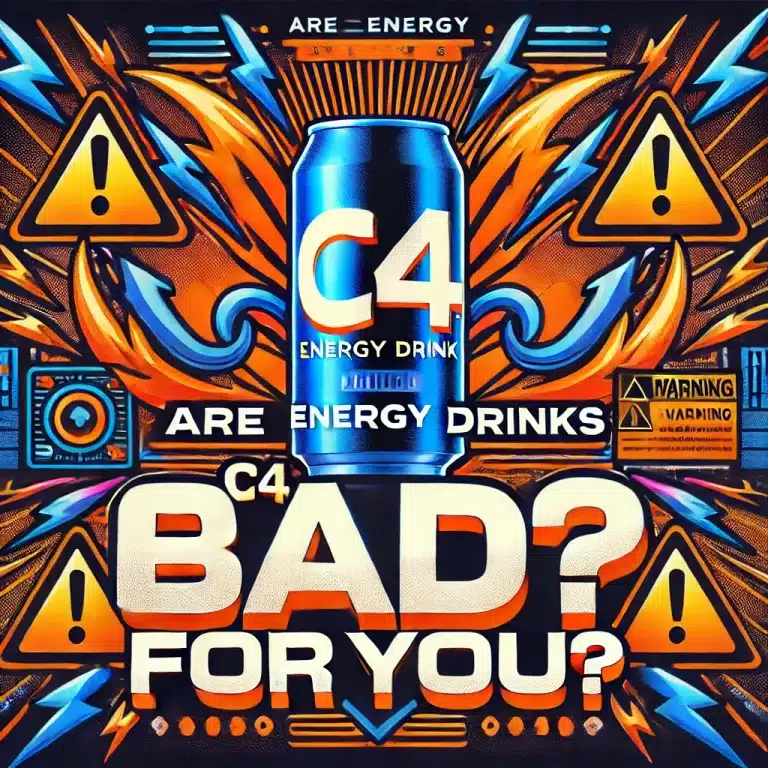EAAs Vs BCAAs: Which One Should You Really Be Taking?
Picture this. You’re browsing pages of bright labels online or strolling through your preferred supplement retailer. One area is crammed with vibrant tubs marked BCAAs and another with EAAs. The assertions are bold and assured. ” Faster recovery!” “Explosive muscular expansion!” “Train longer, feel stronger!” But as a customer, you start to wonder, what distinguishes these two? Should you be consuming both or one over the other? Alternatively is this only another example of marketing hoopla aimed at extracting a few more dollars from your pocket?
Let me say straight forwardly to you. I visited there as well, standing before those identical racks and wondering which one would change the outcome for my workouts. Finding out what worked best for my body took time, study, and some trial and error. And the reality? It’s not only about which one is “better”; it’s also about which one fits your goals, workout intensity, and eating pattern. Therefore, let’s dissect this logically; no degree in science is needed.
What Are EAAs?
Nine amino acids known as Essential Amino Acids, or EAAs, are ones your body cannot create on its own. You must thus receive them via food or supplements. These nine comprise lysine, methionine, phenylalanine, threonine, tryptophan, histidine, isoleucine, and valine. Though each serves a different purpose in different body systems, taken as a whole, they are very essential for one main process that counts most to both athletes and lifters. Muscle protein synthesis. Your body uses this biological process to rebuild and strengthen muscular tissue. This process can stop or be less effective without all nine EAAs at hand.
I find this analogy to be appropriate: Imagine trying to bake a cake and you have everything you need, except eggs. Without the eggs, the cake simply isn’t going to come out right regardless of how many other components you have. Your body loses one or more of these vital amino acids, and this results in Whether you just finished your workout and leucine from your BCAA drink flooding your muscles or not matters. Your body really cannot effectively complete the process of muscle repair and rebuilding without the other eight EAAs.
What Are BCAAs?
Comprising just three of the nine essential amino, leucine, isoleucine, and valine, BCAAs, or Branched-Chain Amino Acids, are a smaller category. Athletes notably value these three since they are digested straight in the muscles rather than the liver, so they may be used more rapidly for energy and repair. Particularly leucine is sometimes hailed as the star of the show as it is so important in starting muscle protein synthesis.
The drawback is that BCAAs can start the muscle-building process but cannot finish it on their own. Like turning the key in a car, you can start the engine but you won’t get very far without fuel and oil (also known as the other EAAs). This is where some of the ambiguity and debate over BCAA supplementation find expression. Many believe they must be creating more muscle since they feel invigorated or recover somewhat faster after using BCAAs. The reality, though, is more complex.
EAAs vs BCAAs: Breaking Down the Differences
A few important distinctions emerge when we side-by-side stack EAAs and BCAAs. First and most clearly, whereas BCAAs only offer three, EAAs offer a complete range of the nine necessary amino acids your body requires. EAAs can thus support whole muscle protein synthesis while BCAAs can only help to partially support it.
Second, regarding muscle discomfort and recovery, both EAAs and BCAAs have some advantages. Studies have indicated that, particularly following high-intensity or eccentric training, BCAAs can help lower delayed onset muscle soreness (DOMS). EAAs, on the other hand, help in mending not only muscle tissue but also connective tissue, immunological function, and hormone control, so perhaps helping complete recovery. Faster bounce-back times and more consistent performance in next sessions follow from that more general assistance.
Third, the problem of efficacy during fasting training arises. If you train early in the morning before breakfast, BCAAs could seem like the best answer. Although they can somewhat help stop muscle breakdown, EAAs provide a more complete protection against catabolism. Serving as a low-calorie complete protein supply, they help your body remain in an anabolic state even during fasted workouts.
Beyond that, EAAs give athletes on low-calorie diets or those with heavy exercise loads more help. Whether from calorie restriction, intense lifting, or endurance activities, your body seeks the whole amino profile to control cellular repair, energy generation, and even neurotransmitter balance while it is under stress. EAAs help you remain physically and psychologically sharp and cover the voids in your diet.
My Personal Experience: Switching From BCAAs to EAAs
The first time I changed from BCAAs to EAAs comes to me. Deep in a cutting phase, I sought to shed body fat while maintaining as much lean muscle mass as feasible. Six days a week, I was hitting the gym, usually training fasted, and drinking a fruit punch-flavored BCAA mix that tasted great but left me wondering whether it was doing much more than quelling my thirst.
I choose to test a premium EAA supplement instead after some research and conversation with other athletes. I discovered I wasn’t feeling as exhausted after a workout during the first week. My energy kept more constant over the day. Oddly enough, too, my sleep got better. I reduced roughly three pounds of fat over the next month, kept to my muscle, and raised my squat and deadlift totals. Was it all related to EAAs? Perhaps not totally. However, I think they helped me recover much better and kept my muscles intact.
Now fast forward: EAAs have evolved into a mainstay of my supplement regimen. I depend on them to keep recuperation tight and training sessions consistent whether I’m dieting, bulking, or maintaining. Although BCAAs still have their place, I save them for smaller training days or when I simply want something to sip on without interfering with my eating plan.
Cost vs Value: Are EAAs Worth the Extra Money?

Cost is one of the main reasons individuals choose BCAAs over EAAs. Usually less expensive and with more flavors are BCAAs. Usually for about $25, you can find a tub; a good EAA supplement might price you $40 or more. The truth is, though, if you are investing in your health, body, and training, occasionally paying a bit more ahead will pay off handsomely down-stream.
Consider it this: Would you rather pay $40 for something with full-spectrum support or $25 for a product with partial benefits? EAAs are the wiser expenditure if your objectives are to maximize performance, recuperation, and muscular maintenance. They might be a basic piece that helps everything else run better, not just another item to toss on your stack.
Remember also the hidden expense of inadequate recovery. You will lose progress if you are regularly sore, underperforming in the gym, or even sick more often from inadequate immune support. Closing those recuperation gaps with EAAs will improve your return on every training session.
When Should You Take EAAs or BCAAs?
One other crucial component of the jigsaw is timing. Usually used intra-workout, BCAAs are a good strategy if you want instant energy and less tiredness. By contrast, EAAs are more flexible. You might have them before, during, or following your workout. Particularly in calorie deficits, they can even be given between meals to stop muscle breakdown.
EAAs are the best approach if you are training fast. Without the calories of a complete meal, they offer a consistent supply of muscle-building nutrients. The difference could be less obvious if you’re in a bulking phase and already get enough protein, but EAAs still improve performance and recovery.
The Science Speaks: What Research Says
Although BCAAs can boost muscle protein synthesis, several studies have demonstrated that without the other vital amino acids, they lack a substantial anabolic effect. According to a 2017 Frontiers in Physiology paper, BCAA supplements by themselves cannot increase muscle growth. On the other hand, trials including complete EAA supplementation revealed stronger muscle regeneration and larger gains in net protein balance.
Another 2019 study in the Journal of the International Society of Sports Nutrition found that compared to BCAAs alone, EAAs administered either before or during resistance training sessions greatly enhanced muscle protein synthesis and lowered muscle protein breakdown. Fundamentally, When it comes to total muscular assistance, the science strongly favors EAAs.
More research has also underlined the importance EAAs play in hormonal balance, metabolic health, and even mood control. Not only for bodybuilders but also for endurance athletes, casual lifters, and even those in weight reduction or recomposition phases, the wider advantages make them a great choice.
FAQ: Common Questions About EAAs vs BCAAs
Can I take EAAs and BCAAs together?
Though it’s not essential, you can technically. BCAAs are already included in EAAs; so, consuming both at once is superfluous. Using a well-formulated EAA supplement already provides leucine, isoleucine, and valine, plus the other six necessary amino acids your body need.
Do I still need EAAs or BCAAs if I drink protein shakes?
Yes. For women, both pills are safe and potent. Amino acids support muscle retention and recovery whether your strength training is HIIT or body recomposition is being worked on.
Do EAAs have calories?
Although most EAA supplements are advertised as zero-calorie since the serving amount is minimal, technically amino acids do include calories, about 4 per gram. Still, it’s interesting to consider whether you are accurately tracking macros.
Can I use EAAs on rest days?
Certainly! Particularly if your protein intake is smaller or you are in a deficit, EAAs can be taken on rest days to enhance muscle recovery and help to preserve an anabolic environment.
Including EAAs or BCAAs into your regimen is about smarter training, improved recovery, and making your effort in the gym pay off beyond the barbell, not only about additional pills. Choose something that fits your way of life, then let your outcomes speak for themselves.
Conclusion: EAAs vs BCAAs—What’s Right for You?
Ultimately, your goals, finances, and training needs will determine which of EAAs and BCAAs best fits you. BCAAs might be great if you’re seeking for something light, cheap, and fit for intra-workout drinking. EAAs are the obvious winner, though, if you’re committed to increasing muscle protein synthesis, maintaining lean mass throughout a cut, or improving your recovery between hard workouts.
They provide better scientific support, more total help, and better alignment with your body’s needs. And even if they could cost a little more, the extra advantages more than pay for the outlay. Supplements are only as good as their capacity to support your real-world performance ultimately. Choose the one that drives your objectives then don’t hesitate to test both and observe how your body reacts.
Because regarding improvements, feeling nice, and training wisely? Rarely do half-measures fit. And in a world of fitness trends, science-based tactics like EAAs provide a real, physical edge you can feel, not only buzz you can read on a label.






